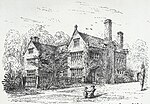Leeswood Hall
Country houses in WalesDovecotesGardens in WalesGrade II* listed buildings in FlintshireGrade II* listed houses ... and 2 more
Houses completed in 1744Registered historic parks and gardens in Flintshire

Leeswood Hall is a country house in Leeswood, Flintshire, Wales. Dating from 1742, it was built for George Wynne, the design being attributed to Francis Smith. Construction reputedly cost £40,000. The hall is a Grade II* listed building. To the northwest of the hall stand the White Gates, which have their own Grade I listing. The gates terminate the view from the hall across the lawns, an early and rare example of 18th century parkland design by Stephen Switzer, and a Grade I listed landscape of national significance.
Excerpt from the Wikipedia article Leeswood Hall (License: CC BY-SA 3.0, Authors, Images).Leeswood Hall
Stryt Cae Rhedyn,
Geographical coordinates (GPS) Address Nearby Places Show on map
Geographical coordinates (GPS)
| Latitude | Longitude |
|---|---|
| N 53.1442 ° | E -3.1189 ° |
Address
Stryt Cae Rhedyn
Stryt Cae Rhedyn
CH7 4ST , Leeswood and Pontblyddyn
Wales, United Kingdom
Open on Google Maps










